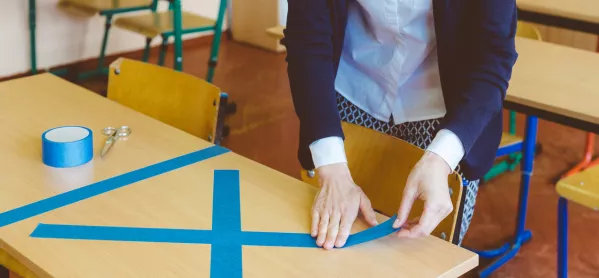- Home
- Ending 2m rule to boost school space a ‘red herring’
Ending 2m rule to boost school space a ‘red herring’

The idea that reducing the two-metre social distance rule will help schools take in more pupils is a “red herring”, headteachers have said.
The government should instead explore the potential to “commandeer” community spaces and invite qualified teachers to return to the profession in order to boost school capacity, according to the Association of School and College Leaders (ASCL).
This morning, it was reported that prime minister Boris Johnson plans to scrap the two-metre rule by September at the latest so that schools can reopen fully for the start of the academic year.
Related: National plan ‘needed to create more school space’
Justine Greening: Schools facing ‘crisis’ unless DfE acts
Coronavirus: Retired teachers may be called on to help schools open
At prime minister’s questions yesterday, Mr Johnson promised to “keep that two-metre rule under constant review”.
And senior Tory MP Tobias Ellwood said yesterday that enforcing the two-metre rule in schools was “incredibly difficult” and argued that reducing the measure to one metre would enable a more smooth return.
“I speak to headteachers and they just say it’s impossible with the two-metre rule to actually do it, so you can see some friction there as well,” he told the BBC.
But Geoff Barton, ASCL general secretary, said changing the rule would make very little difference to schools’ ability to cater for more pupils, as it is just one of a “complex set of measures” that they must adhere to.
“The idea that reducing the two-metre rule will greatly increase the capacity of schools to take in more pupils is a red herring,” he said.
“The existing government guidance already recognises that it is not always possible to maintain a distance of two metres from others in education settings.
“And social distancing is only one of a number of control measures which limit capacity. One of the other main principles of the existing guidance is that teachers and children should remain in small groups to reduce mixing with others.
“Bringing more children back into schools beyond the eligible groups already identified requires a much more sophisticated, and coordinated approach which needs to involve the government, local authorities, and schools, guided by public health advice.”
Mr Barton said one way to boost school capacity could be to “commandeer” public spaces such as community centres and village halls, and bring back qualified teachers - but, as schools “don’t have the power to do this”, it must be looked at “as part of a national plan”.
He added: “What is certain is that a much greater sense of urgency is required in developing a coherent plan for the recovery of education.”
The NEU teaching union has also urged the government to create a “national plan for education” which includes the “requisitioning of local public spaces” to ease pressure on schools during the coronavirus crisis.
Mary Bousted, NEU joint-general secretary, said buildings such as libraries and community centres should be made available for schools to use so more children are able to continue their education in “safe environments”.
And former education secretary Justine Greening has said there are “plenty” of spaces that are not currently being used, which could be repurposed to help schools to accommodate more children.
The prime minister’s offical spokesperson said yesterday that the use of retired teachers and community spaces to help schools reopen to more pupils has “not been ruled out”.
Speaking today in the House of Commons, Jacob Rees-Mogg told MPs to “think back to our school days” when considering whether the current two-metre social distancing rule should be reduced to one metre.
He said: “The government is, of course, considering this in relation with its scientific advisers. But I think we need to think back to our school days because it’s all about Pi-R-squared.
“That if the radius is doubled, the area quadruples and that is the difference that is made, but that applies both to the numbers you can include in an area, but also to the transmission of the disease and that is why the government is considering these issues in both directions.”
Keep reading for just £1 per month
You've reached your limit of free articles this month. Subscribe for £1 per month for three months and get:
- Unlimited access to all Tes magazine content
- Exclusive subscriber-only stories
- Award-winning email newsletters



